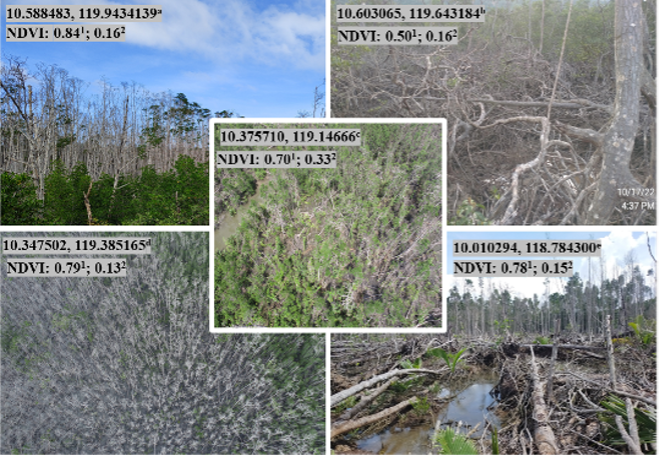VOLUME 17 (Supplement)

SciEnggJ 17 (Supplement) 443-454
available online: December 31, 2024
DOI: https://doi.org/10.54645/202417SupCQB-63
*Corresponding author
Email Address: montoyapia@gmail.com
Date received: 19 February 2024
Date revised: 1 May 2024
Date accepted: 25 July 2024
ARTICLE
Typhoon-induced mangrove changes and its impacts on livelihood resources in Palawan, Philippines
Technology, Pathum Thani, Thailand
2Palawan, Philippines
Raising global climate change has increased the frequency and severity of typhoons, posing a serious threat to mangroves and the well-being of coastal communities. These typhoons contribute to a loss of 10% of the mangrove cover each year, but little attention has been paid to the impact of typhoons on mangroves in Southeast Asia. This study fills this knowledge gap by assessing the aftermath of Typhoon Rai and its impact on mangroves and livelihoods in Palawan, Philippines. Sentinel-2 satellite images were utilized to conduct a normalized difference vegetation index analysis and compare vegetation conditions before (2021) and after the typhoon (2022). In addition, household survey interviews involving 266 household heads and key informant interviews with 12 entities responsible for mangrove management were conducted to assess their impact on livelihood. Focus group discussions and field visits were conducted to validate and supplement the collected data. The results showed significant changes in mangrove cover between the pre-typhoon and post-typhoon periods. Dense mangrove areas have experienced a decline of about -96% (-15,091.1 hectares), while sparse and bare mangrove areas have declined by 1,650 % (13,605.1 hectares) and 192% (1,485.8 hectares), respectively. Following mangrove changes, ecosystem goods and services have also changed. Mangrove-dependent households experienced a decline in the yields of shrimp, crabs, mangrove clams/clams, mangrove snails, sea cucumbers, and nipa (Nypa fruiticans), and a decline in ecotourism businesses. In particular, there was an increase in the yield of woodworms (tamilok), the felling and collection of mangrove wood/poles, recreational/tourism activities, and research initiatives. Nevertheless, total revenue from mangrove resources decreased by about 50%, a loss of PHP 77,8560 (USD 1,406) compared to pre-typhoon levels in 2021, amounting to PHP 154,886.90 (US$2,796.15) on average. Although some communities recognize typhoon-related mangrove operations, household participation remains low. This study highlights the need for targeted mangrove interventions, particularly in denuded areas, to accelerate recovery and mitigate losses to mangrove ecosystems and livelihoods. Additionally, providing livelihood support to households that lack coping strategies can help stabilize their income until mangrove ecosystem services are restored.
© 2025 SciEnggJ
Philippine-American Academy of Science and Engineering